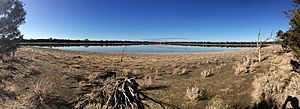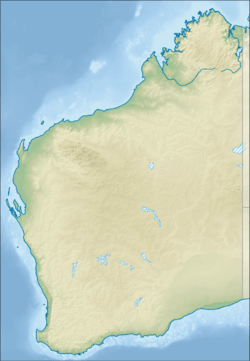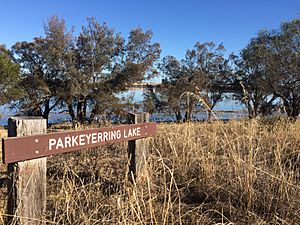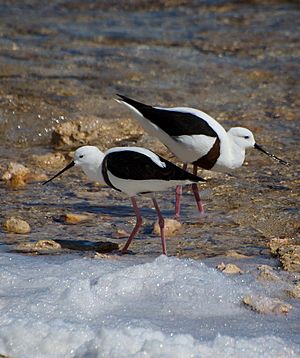Parkeyerring Lake facts for kids
Quick facts for kids Parkeyerring Lake |
|
|---|---|

Parkeyerring Lake 2018
|
|
| Location | Wheatbelt, Western Australia |
| Coordinates | 33°22′04″S 117°20′48″E / 33.36778°S 117.34667°E |
| Type | saline |
| Primary inflows | Groundwater and surface runoff |
| Basin countries | Australia |
| Surface area | 322 ha (800 acres) |
| Average depth | 0.86 m (2 ft 10 in) |
| Surface elevation | 247 m (810 ft) |
Parkeyerring Lake is a special kind of salt lake in the Wheatbelt area of Western Australia. It's about 7 km (4.3 mi) south of the town of Wagin and about 235 km (146 mi) southeast of Perth. This lake is "ephemeral," which means it only has water at certain times, usually after it rains.
A large part of the lake is surrounded by the Parkeyerring Nature Reserve. This reserve is 991 ha (2,450-acre) big and was officially created in 1905, then made even bigger in 1957.
The traditional owners of this land are the Noongar peoples. They belong to the Gnaala Karla Booja region, which includes the Pindjarup, Wiilman, and Ganeang groups. There are many important Aboriginal sites all around this area, including near the lake.
Contents
About Parkeyerring Lake
Parkeyerring Lake covers an area of 322 ha (800 acres). It fills up with water from small streams and channels that flow in from its southern and southwestern sides. Little Lake Parkeyerring is also located nearby. Water also seeps into the lake from the ground and rocky areas on its western side. The main way water leaves the lake is through a channel on the northeastern side, which flows into the Coblinine River. Most of the land around the lake has been cleared for farming.
The area gets about 450 mm (18 in) of rain each year. However, about 1,700 mm (67 in) of water evaporates (turns into vapor) each year because of the sun and wind. The land here has gentle hills, flat areas, and slightly rolling rises.
Chain of Wetlands
Parkeyerring Lake is part of a series of wetlands (areas of land covered by water, like swamps or marshes). These wetlands follow old natural water paths in the area. They stretch from Dumbleyung in the north down to south of Wagin. The Shire of Wagin has many large lakes and wetlands, including parts of Lake Dumbleyung, Lake Parkeyerring, Lake Little Parkeyerring, Lake Quarbing, Lake Norring, Lake Little Norring, Lake Gundaring, and Wagin Lake.
These lakes are part of the Blackwood River's water system. But because the land is very flat, there isn't much rain, and there are many salt lakes, the streams and rivers in the eastern part of the area usually don't flow into the Blackwood River.
In the early 1900s, people from Wagin and nearby towns used to have picnics at the lake and its surroundings.
Wait-Jen Trail
The Wait-Jen trail is a 10.5 km (6.5 mi) walking path that goes past the lake. It ends at Norring Lake, which is to the southwest. In the local Noongar language, Wait-Jen means emu’s foot print. The trail follows an ancient dreamtime path that was taken by the Wagyl, a mythical rainbow serpent. The trail was opened in 2003 and has signs and information panels to teach visitors about the area.
Plants of the Lake
Around the edges of Parkeyerring Lake, there's a narrow strip of plants.
- On the eastern side, you'll mostly find Eucalyptus loxophleba trees with smaller Acacia acuminata plants underneath.
- The western side of the lake has a woodland area with many Casuarina obesa trees.
- On the northern edge, you can find Melaleuca halmaturorum trees.
- Closer to the water, in the low-lying areas, you'll see plants like Samphire, Halosarcia lepidosperma, and different types of Sarcocornia. These plants are good at growing in salty soil.
Animals of the Lake
Many different animals live in and around Parkeyerring Lake.
Waterbirds
Eighteen different kinds of waterbirds have been seen at the lake. Some of the most common ones are the salt-loving Australian shelduck and the banded stilt. There are also many silver gulls, possibly because a waste disposal site is nearby.
Other waterbirds with smaller populations include:
- Black swan
- Black-winged stilt
- Curlew sandpiper
- Eurasian coot
- Grey teal
- Hooded plover
- Pacific black duck
- Pink-eared duck
- Red-capped plover
- Hoary-headed grebe
- White-faced heron
- Australasian shoveler
- Red-necked stint
Crustaceans and Insects
Scientists have found six types of crustaceans (like tiny crabs or shrimp) in the lake. These include Australocypris insularis, Diacypris compacta, and Platycypris baueri.
Three types of insects have also been recorded: Necterosoma penicillatus and a species of Tanytarsus.
Other Animals
The endangered red-tailed phascogale, a small marsupial, has also been seen in the nature reserve around the lake.




